Conquering the Scottish Winter: Your Ultimate Campervan Guide!
So, you’ve decided to embrace the wild beauty of Scotland in the depths of winter from the cosy comfort of your campervan? You, my friend, are either fearless, slightly unhinged, or possess an admirable sense of adventure. Whichever it is, you’ve come to the right place!
Winter in Scotland is a genuinely magical – think snow-capped mountains, crisp air, and the chance to witness the Northern Lights without the summer crowds. But it can also be a formidable adversary if you’re not prepared – but fear not! This guide will equip you with everything you need to winter-proof your campervan and make your late-year Scottish road trip not just comfortable, but genuinely unforgettable.
Why in Winter?
Let’s start with the “why.” Beyond the obvious aesthetic appeal of a snow-dusted landscape, winter offers a unique tranquillity. Popular spots that are teeming with tourists in summer become havens of peace.
Additionally, the chances of witnessing dramatic skies, incredible sunrises and sunsets (even if brief), and the elusive Aurora Borealis increase significantly. Just be prepared for shorter daylight hours and the possibility of some seriously challenging weather!
This is exactly why your motorhome needs to be ready for anything!
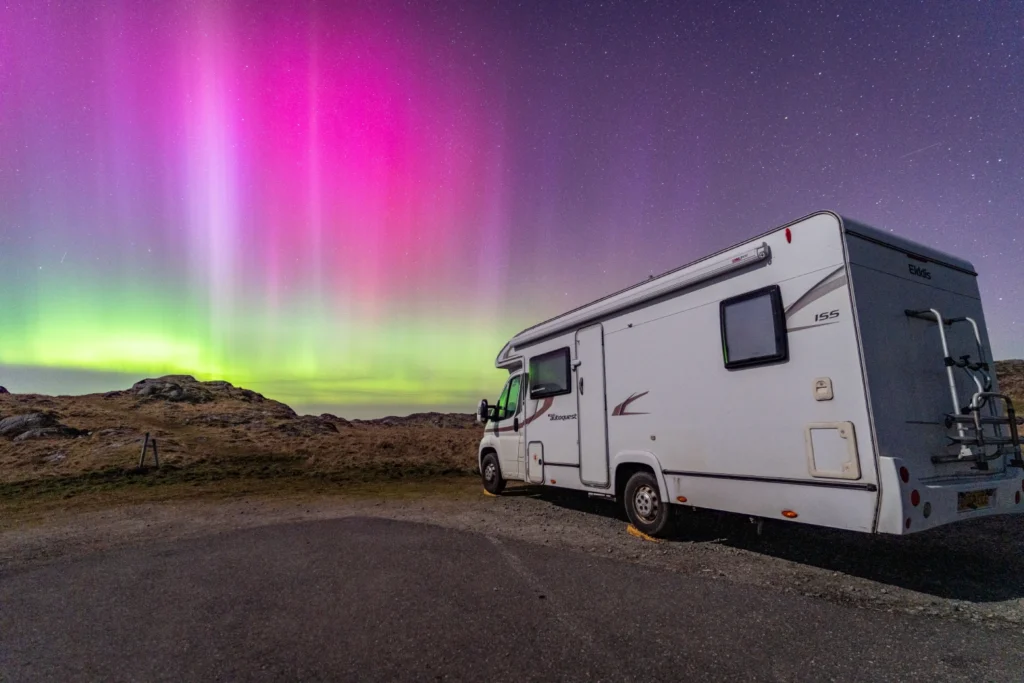
Table of Contents
The Golden Rule: Safety First, Always!
Before we delve into the specifics of upgrades and equipment, let’s discuss safety. Campervanning isn’t just about comfort; it’s about survival.
Road Conditions
Scottish winter roads can range from clear to treacherously icy and snow-covered in a matter of miles.
- Check Forecasts Relentlessly: Before setting off each day, and even during the day, check the Met Office and Traffic Scotland websites. Pay particular attention to localised forecasts for mountain passes.
- Know Your Vehicle’s Limits: Is your van 2WD or 4WD? What’s its ground clearance? Don’t push it. If a road looks dodgy, turn back. There’s always another route or another day!
- Emergency Kit Essentials: Beyond the usual, pack a heavy-duty shovel, sand or grit for traction, a tow rope, and booster cables.
- Charge Your Phone: Always keep a fully charged phone and a power bank on hand. Signal can be patchy in remote areas, but it’s vital for emergencies.
- Tell Someone Your Plans: Let a friend or family member know your route and expected arrival times!
Health and Well-being
Hypothermia and frostbite are real risks for travellers braving the winter, especially in remote areas and mountain trails.
- Layer Up: Think thermal base layers, fleece, and a waterproof/windproof outer shell.
- Stay Hydrated: Even in the cold, it’s easy to get dehydrated. Pack plenty of high-energy snacks and hot drinks.
- Watch for Symptoms: Educate yourself on the signs of hypothermia and frostbite.
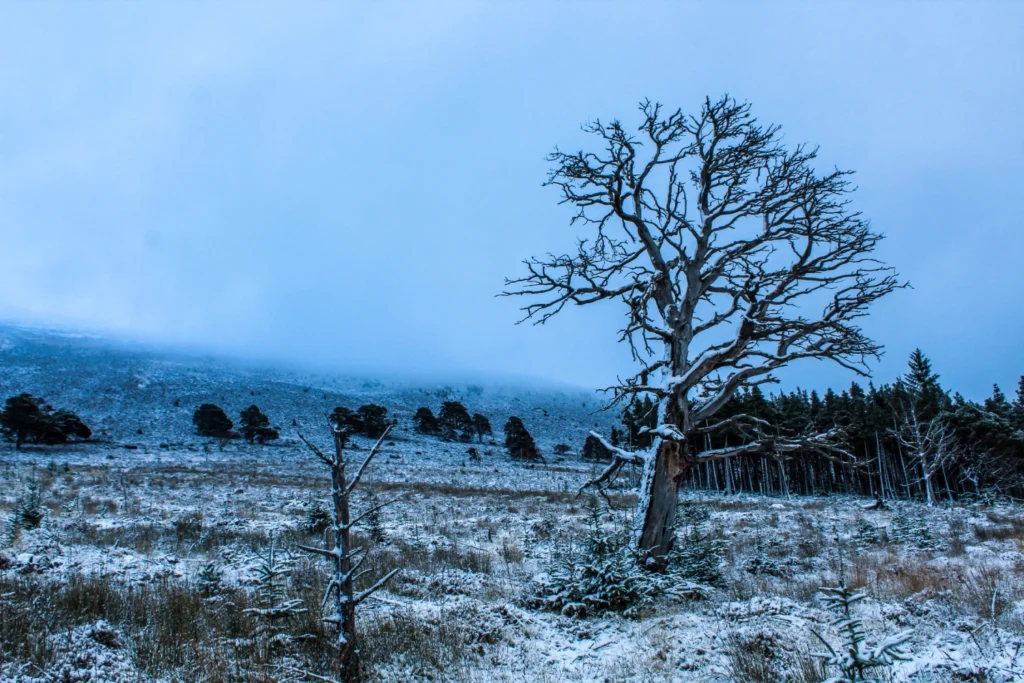
Planning Your Trip
We use the below booking platforms to plan our trips. We hope you find them useful too!
Essential Campervan Equipment
The right upgrades are where your campervan starts to transform from a summer cruiser into a winter warrior!
- Winter Tyres: Non-negotiable. Seriously. All-season tyres are not enough. Winter tyres provide superior grip on cold, wet, icy, and snowy roads.
- Snow Chains/Socks: Even with winter tyres, you might encounter conditions requiring extra traction. Learn how to fit them before you go.
- External Thermal Screens: Cover your cab windows. They drastically reduce heat loss and condensation. Internal blinds are a start, but external ones are far superior.
- Warm Bedding: A good quality, four-season sleeping bag or a thick duvet and blankets are crucial. Consider a heated blanket if you have access to shore power.
- Proper Clothing: We’ve mentioned layering, but specific items like waterproof gloves, hats, and warm, waterproof boots are indispensable.
- De-icer and Scraper: For those frosty mornings.
- Small Shovel and Grit/Sand: For digging out snow or providing traction under wheels.
- High-Powered Torch/Headlamp: With shorter daylight hours, you’ll be navigating in the dark more often.
- Carbon Monoxide Detector: Essential if you’re using gas heaters or cooking inside. Check batteries regularly.
- First Aid Kit: Stocked for cold-related injuries and general travel ailments.
- Plenty of Water: Even if your tank is frozen, you’ll need drinking water.
- Spare Fuel: Especially if venturing into remote areas where petrol stations are few and far between.
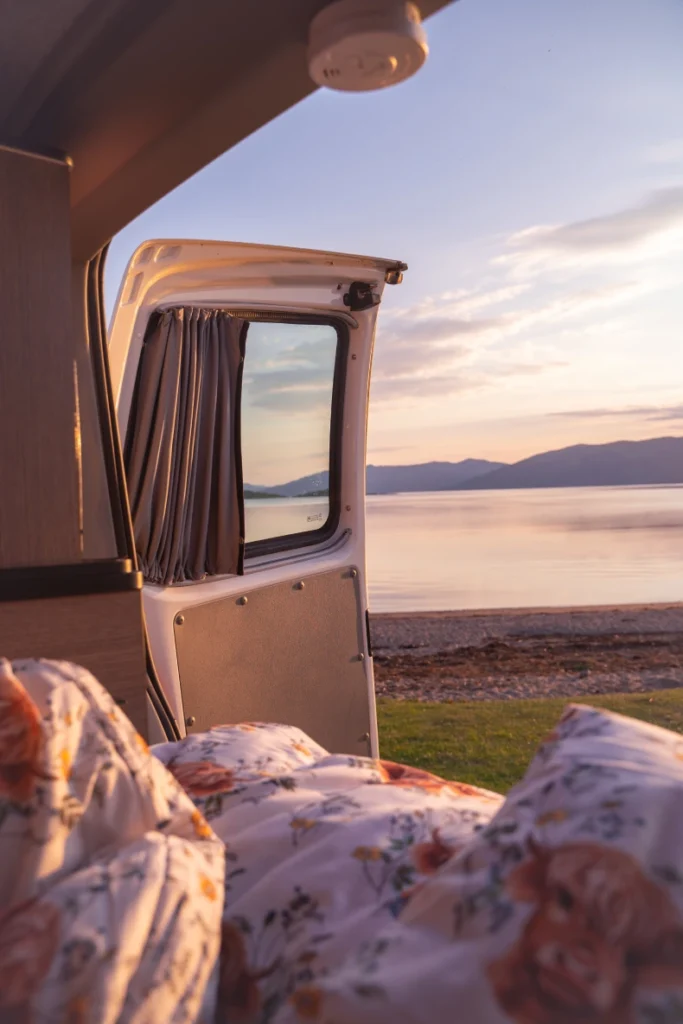
Vanlife Upgrades: Winter-Proofing Your Camper
This is where the fun begins for the DIY enthusiast (or someone with a mechanic’s phone number!). Regardless of whether you’re an owner or a renter, this list should be useful to double-check equipment!
Insulation
- Walls, Floor, Ceiling: If your van isn’t already well-insulated, this is the number one upgrade. PIR boards, sheep’s wool, or even recycled plastic bottle insulation can make a huge difference. Don’t forget to seal gaps!
- Window and Door Insulation: As mentioned, external thermal screens are great. For fixed windows, consider adding secondary glazing or thick, thermal curtains.
Heating (Stay Toasty!)
- Diesel Heater (Eberspächer/Webasto): This is the gold standard for campervan heating. They draw fuel directly from your van’s tank, are efficient, and can run for long periods. Installation can be complex, so we recommend getting a professional.
- Gas Heaters: While effective, be mindful of proper ventilation and the potential for carbon monoxide exposure. A blown-air gas heater integrated into your system is safer than portable units.
- Electric Heater: Only valid if you plan to stay at campsites with an electric hookup. Not practical for off-grid winter camping.
Fan Heater: Can quickly warm a small space, but again, requires hook-up.

Water Systems
- Insulated Water Tanks and Pipes: Wrap your fresh and grey water tanks and exposed pipes with insulation. Heat tracing cables can also prevent freezing, especially for exterior pipes.
- Internal Tanks: Situate your water tanks inside the heated living space.
- Drain Down: If temperatures are going to be consistently below freezing and you won’t be using water for a while, drain down your entire system to prevent pipes from bursting.
- Antifreeze for Grey Water: A small amount of non-toxic RV antifreeze in your grey water tank can prevent it from freezing solid.
Electrics
- Leisure Battery Capacity: Cold weather significantly impacts battery performance. Consider upgrading to a larger leisure battery or a lithium-ion battery for better cold-weather performance and deeper discharge cycles.
- Solar Panels: Still useful, but expect significantly reduced output in winter due to shorter days and lower sun angles. Keep them clear of snow!
- Battery Monitor: Essential for keeping an eye on your power consumption and remaining battery life.
- Shore Power Hook-up: Access to mains electricity at campsites allows you to run more power-hungry appliances and charge your batteries fully.
Ventilation
- Roof Fan/Vent: Crucial for managing condensation, which will be a significant issue in cold weather. A reversible fan can pull cold, dry air in or push moist air out.
- Dehumidifier: A small desiccant dehumidifier can work wonders in reducing moisture, especially when not running your heating constantly!
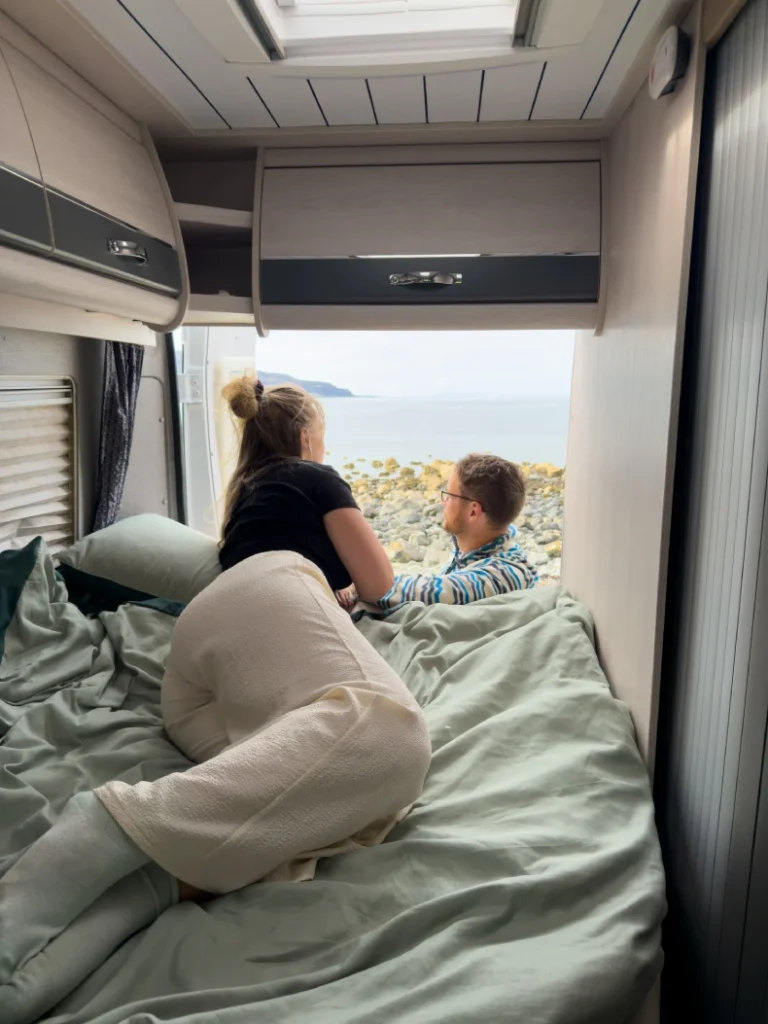
Eating & Exploring
Beyond the standard camping fare, think warm and comforting. While hearty Scottish food in pubs, cafes and restaurants is perfect to warm up with after a winter wander, never plan to eat out somewhere unless you’ve double-checked the seasonal opening times – service may be limited, particularly in more remote spots!
Endeavour to stock up so you’re never let down! Start with these:
- Hot Drinks: Tea, coffee, hot chocolate, instant soup.
- Hearty Dishes: Stews, pasta dishes, anything that warms you from the inside out.
- Easy Meals: When it’s cold, you don’t want to spend ages cooking.
- Emergency Rations: Non-perishable food in case you get stuck somewhere.
Where to Go (and Where to Avoid)
- The Highlands: Stunning, but also the most challenging. Be prepared for road closures and very remote conditions.
- Coastal Routes: Often milder, but still subject to strong winds and rain.
- Specific Destinations: Areas like the Cairngorms National Park are ideal for winter sports, but require extreme caution. Consider specific winter campsites that offer facilities like heated shower blocks.
Avoid
- High mountain passes: Unless you’re an experienced winter driver with appropriate gear, you could risk being trapped in very tricky, very remote areas where help might be hours away. Don’t be a hero!
Final Advice
Winter campervanning in Scotland isn’t for the faint of heart, but it’s a gratifying experience.
Be prepared, be flexible, and most importantly, be respectful of the weather. If the forecast looks dire, change your plans. Embrace the unexpected detours, the cosy evenings tucked away in your cosy sanctuary, and the sheer exhilaration of witnessing Scotland’s raw, untamed beauty in its most dramatic season.
You’re not just taking a road trip; you’re embarking on a true adventure.
Happy (and safe!) travels!
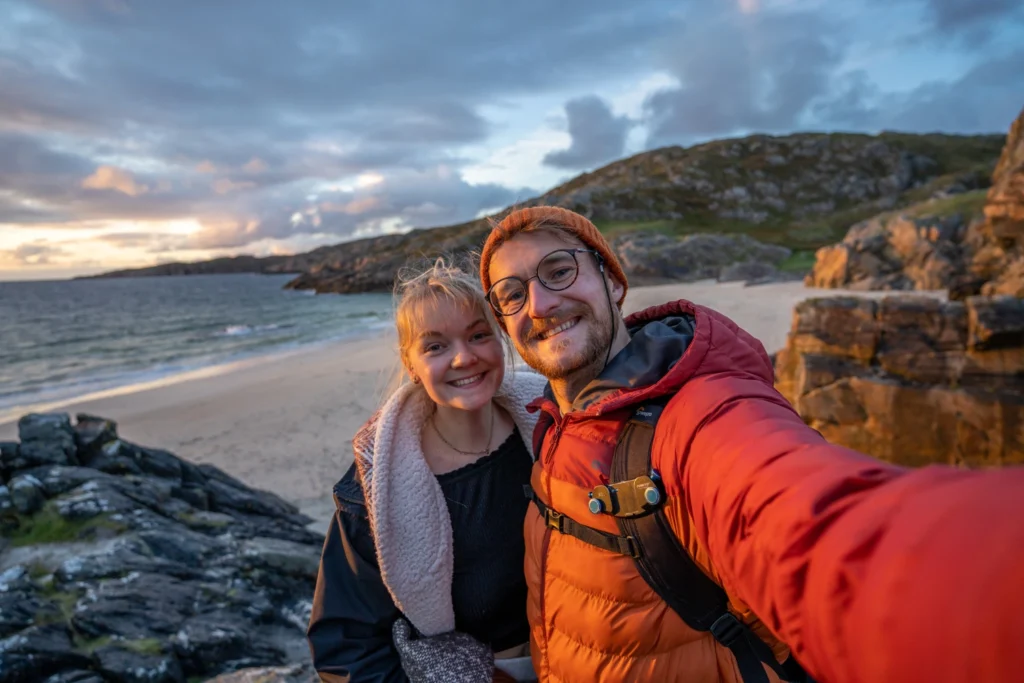
Useful Links
- Met Office: https://www.metoffice.gov.uk/
- Traffic Scotland: https://www.traffic.gov.scot/
- Historic Scotland: https://www.historicenvironment.scot/
- Cal Mac Ferries: https://www.calmac.co.uk/en-gb/
- Our Website: https://highlands2hammocks.co.uk/


